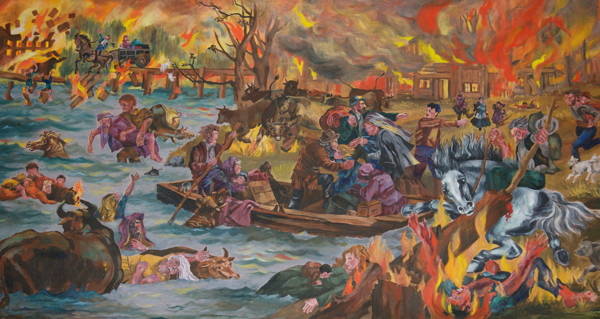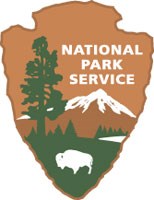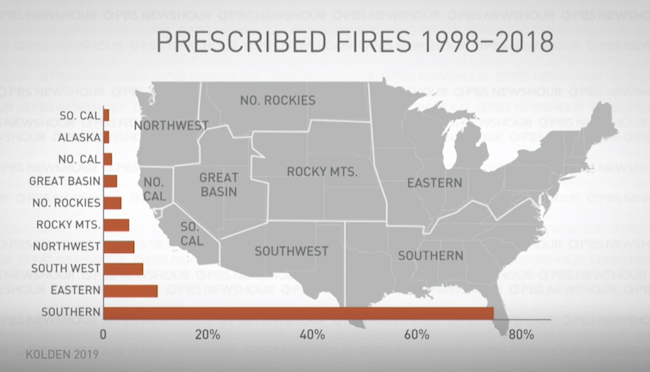Cover Photo Credit: Huldin 2019
Welcome to Fire Policy – Then & Now. This blog will compare and contrast fire policy in the United States at various points in history and will explore the drivers of these changes in social acceptance, policy, and ultimately, the ecology of the U.S. landscape.
Photo Credit: CNY Central 2020
Traditional Roots – Total Fire Suppression
In the article, “Paiute Forestry,” published in 1920 by Chief Greenley, the author praises the complete fire suppression of western forests and refers to those in favor of prescribed burning as “Forest Burners.” This movement of total fire suppression was not unusual at its time. Many historical factors were at play to shape the cultural support of suppression. The deadliest fire in U.S. history, the Peshtigo Fire, occurred in 1871, and this was followed by the Big Burn of 1910 which devastated over 3 million acres in western forests. These events coupled with the protection of big timber and European fire suppression techniques created a receptive stage for policy makers and overall American culture to favor fire suppression. Fire was seen as an enemy to be beat and reinforced by laws like the 10 am policy, mainly exercised by the U.S. Forest Service. In 1910, Chief Graves stated that, “fire protection was 90% of American Forestry.”

Photo Credit: Minnesota Public Radio 2002
The 1960s – A Time of Change
Fire suppression was the prevailing doctrine in wildfire management until the 1960s when examination of the economic validity of fire suppression began to be questioned. People also began learning the role of wildfire in an ecosystem. National Parks and Wilderness areas were some of the first places to experiment with the return of prescribed burns; however, a few famous prescribed burns in National Parks escaped and became wildfires, which had lasting implications for the public concerning the validity of prescribed burns in western forests (Donovan & Brown, 2005).

Photo Credit: NPS 2019
Fire Management Now – The Past Lives On
Fire management now maintains doctrines from each time period in history. The focus on suppression and society’s reluctance to participate in prescribed burning persists to this day. Many people’s motivation remains to fight and control the fire at all cost, when in reality this only deters and exaggerates its impact. In the PBS NewsHour interview with Professor Kolden (2019), the graph of the regional sections of the United States that participate in prescribed burning is significantly lower in the western states compared with the southeast.

Photo Credit – PBS NewsHour, Kolden 2019
The Future of Fire Management – Good News
The good news is that scientific research supporting prescribed burning and fuels reduction is growing and backed by policy like the Federal Wildland Fire Management Policy of 1995 and the National Fire Plan of 2000. The rationale and motivation of those who embrace prescribed burning is to allow fire to serve its role in the ecosystem, reduce fuels, allow for balanced forest growth, and in turn, allow for less damage to natural areas, people, and property. Prescribed burning is one way to combat the mega-fires, fires that burn more than 100,000 acres, that are increasingly common today (Hessburg, 2017). Based on today’s wildfire situation, it is clear that society and policy-makers must evolve from our traditional fire suppression roots and embrace a more ecological and scientific approach to fire management in the form of prescribed burning.
Photo Credit: CNY Central 2020
References
Donovan, G.H. and Brown, T.C. (2005). “Wildfire management in the US Forest Service: a brief history.” Natural Hazards Observer. July (2005). 3 p. Retrieved from https://www.fs.fed.us/pnw/pubs/journals/pnw_2005_donovan003.pdf
Greeley, W. (2000). “Paiute Forestry” or the fallacy of light burning. Fire Management Today, 60(4), 21. Retrieved from https://search-proquest-com.ezproxy.proxy.library.oregonstate.edu/docview/232961923/fulltextPDF/F9C9481F270B4A57PQ/1?accountid=13013
Hessburg, P. (2017, Jul. 6). “Living (dangerously) in an era of megafires.” TedxTalks. Retrieved from https://www.youtube.com/watch?time_continue=15&v=edDZNkm8Mas&feature=emb_logo
PBS (2019, Jun. 9). “With rise in US fires, prescribed burns may be a solution.” PBS Newshour. Season 2019 Episode 178. Retrieved from https://www.youtube.com/watch?v=EY5dSzWHpzM


2 replies on “Fire Policy – Then & Now”
Hi, this is a comment.
To get started with moderating, editing, and deleting comments, please visit the Comments screen in the dashboard.
Commenter avatars come from Gravatar.
Hi Elise,
You’ve created a beautiful and intuitive post with easy-to-follow divisions between past, present, and future. I appreciate your focus on recent history and the future of fire management. It is true that prescribed fire is still a contentious issue, especially now that so many people live in areas that are difficult to defend. I have witnessed this push back in person while working at Rocky Mtn NP where small prescribed fires are just now being accepted by the community. You mention fuels reduction as one of the current strategies, and maybe this will end up being the most feasible and acceptable way to return our forests to a healthy, fire resistant state. At the very least, fuels reduction can begin to address the issue while public education about prescribed fire continues. Thanks for your wonderful post!
Ann